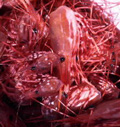Water: Contaminated Sediments
Species Affected






Sediments are home to a wide variety of aquatic life, including worms, clams, mussels, crustaceans, and insects. Field observations suggest, and laboratory tests confirm, that contaminated sediments can be lethal to benthic organisms such as crustaceans and insect larvae. These creatures occupy important positions on the food chain that leads up to larger fish like trout, bass, and salmon and to fish-eating wildlife such as mink, pelicans, cormorants, and bald eagles.
If the smaller animals lower on the food chain die due to toxic contaminants in the sediment, the larger animals further up the chain will lose their supply of food. On the other hand, if the smaller animals accumulate toxic contaminants in their tissue and survive, the larger animals may take in dangerous levels of toxins when they eat the smaller ones.
People can be exposed to dangerous levels of toxic contaminants when they eat animals high on the food chain, such as salmon and trout. There also is the potential for exposure to toxic contaminants through direct contact with contaminated sediments. Anglers, hunters, waders, and swimmers could be at risk.
Should people continue to eat fish?
Concerned about biomagnification, the increased accumulation and concentration of contaminants at higher levels of the food chain, many consumers wonder whether they should continue to eat fish. The answer is not a simple yes or no. Fish is a good source of protein and other nutrients, and commercial seafood typically comes from unpolluted areas. But, people should avoid eating unsafe amounts of fish that might be contaminated. Anyone planning a recreational fishing trip, or who regularly eats fish caught from one body of water, should check with the state health department to learn if any fish-consumption warnings or advisories are in effect. Some advisories highlight groups that are at special risk, including young children, the elderly, pregnant and nursing women, and individuals whose immune systems are impaired. The Fish Advisories Website contains more information on fish consumption.
Our database, National Listing of Fish Advisories, contains all available information on current fish-consumption advisories in the United States and Canada. It also contains wildlife advisories for other species such as frogs and turtles.
Please note that not all fish advisories are related to contaminants in sediment; some advisories are due to contaminants in other places, like water itself.
